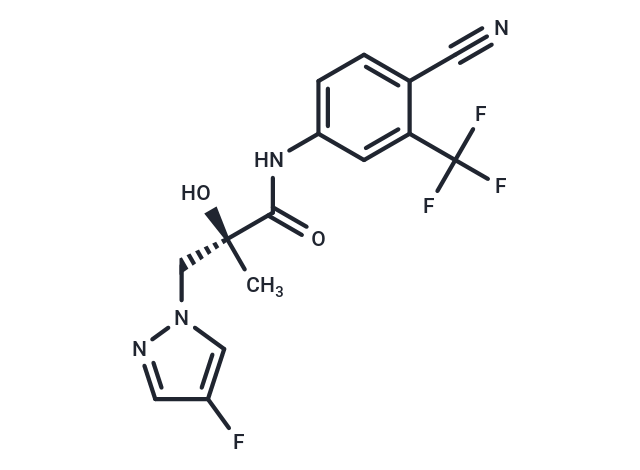Shopping Cart
Remove All Your shopping cart is currently empty
Your shopping cart is currently empty
UT-34 is a selective and orally active antagonist of second-generation pan-androgen receptor (AR) and degrader(IC50s of 211.7 nM, 262.4 nM and 215.7 nM for wild-type, F876L and W741L AR, respectively), and has anti-prostate cancer efficacy.

| Pack Size | Price | USA Warehouse | Global Warehouse | Quantity |
|---|---|---|---|---|
| 1 mg | $48 | In Stock | In Stock | |
| 5 mg | $122 | In Stock | In Stock | |
| 10 mg | $196 | In Stock | In Stock | |
| 25 mg | $372 | In Stock | In Stock | |
| 50 mg | $562 | In Stock | In Stock | |
| 100 mg | $868 | In Stock | In Stock | |
| 1 mL x 10 mM (in DMSO) | $133 | In Stock | In Stock |
| Description | UT-34 is a selective and orally active antagonist of second-generation pan-androgen receptor (AR) and degrader(IC50s of 211.7 nM, 262.4 nM and 215.7 nM for wild-type, F876L and W741L AR, respectively), and has anti-prostate cancer efficacy. |
| Targets&IC50 | W741L AR:215.7 nM , AR (wild-type):211.7 nM , F876L AR:262.4 nM |
| In vitro | In LNCaP cells, UT-34 (3-10 μM; 24 hours) treatment inhibits the expression of PSA and FKBP5 and growth of LNCaP cells starting from 100 nM with maximum effect observed at 10 μM[1].In LNCaP cells UT-34 (0.1-10 μM; 24 hours; LNCaP cells) treatment results in a reduction of AR levels at 1000 nM [1]. Treatment of ZR-75-1 cells maintained in serum-containing growth medium with UT-34 results in downregulation of AR protein levels, but not estrogen receptor (ER) or progesterone receptor (PR) levels. Furthermore, in MDA-MB-453 breast cancer cells that express AR and glucocorticoid receptor (GR), UT-34 induces the downregulation of AR, but not GR[1]. UT-34 is an effective degrader of both AR and AR-V7.LNCaP-ARV7 cells were treated in the presence of 0.1 nM R1881 or 10 ng/mL doxycycline for 24 hours. Doxycycline induces the expression of EDN2, which is inhibited by UT-34, and UT-34 inhibits the expression of FKBP5 gene expression induced by R1881[1]. |
| In vivo | In NSG mice, UT-34 (20-40 mg/kg; oral administration; daily; for 14 days ) at 20 and 40 mg/kg reduces the seminal vesicle weight by 10%-20% and 50%-60 %, respectively[1]. in rats,UT-34 inhibits androgen-dependent tissues such as prostate and seminal vesicles , and the growth of Enzalutamide-resistant castration-resistant prostate cancer (CRPC) xenografts. In intact immunocompromised rats, UT-34 also induces tumor regression [1]. |
| Molecular Weight | 356.27 |
| Formula | C15H12F4N4O2 |
| Cas No. | 2168525-92-4 |
| Smiles | C[C@](O)(Cn1cc(F)cn1)C(=O)Nc1ccc(C#N)c(c1)C(F)(F)F |
| Relative Density. | 1.42 g/cm3 (Predicted) |
| Storage | Powder: -20°C for 3 years | In solvent: -80°C for 1 year | Shipping with blue ice/Shipping at ambient temperature. | |||||||||||||||||||||||||||||||||||
| Solubility Information | DMSO: 71 mg/mL (199.29 mM), Sonication is recommended. | |||||||||||||||||||||||||||||||||||
| In Vivo Formulation | 10% DMSO+40% PEG300+5% Tween 80+45% Saline: 2 mg/mL (5.61 mM), Sonication is recommended. Please add the solvents sequentially, clarifying the solution as much as possible before adding the next one. Dissolve by heating and/or sonication if necessary. Working solution is recommended to be prepared and used immediately. The formulation provided above is for reference purposes only. In vivo formulations may vary and should be modified based on specific experimental conditions. | |||||||||||||||||||||||||||||||||||
Solution Preparation Table | ||||||||||||||||||||||||||||||||||||
DMSO
| ||||||||||||||||||||||||||||||||||||
| Size | Quantity | Unit Price | Amount | Operation |
|---|

Copyright © 2015-2025 TargetMol Chemicals Inc. All Rights Reserved.